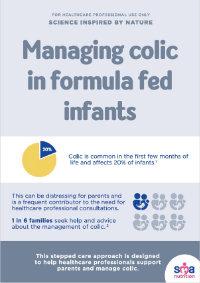A stepped care approach for managing colic in formula-fed infants
Colic is common in newborns and affects 20% of babies in the first few months of life.1 This can be distressing for parents and their babies and it is a frequent contributor to the need for healthcare professional consultations. The continuous inconsolable crying of an infant without obvious cause can be very difficult for parents to manage and 1 in 6 families seek help and advice on how to deal with colic.2
This stepped care approach is designed to help healthcare professionals support parents and manage their baby’s colic.
1. Identifying the signs of colic
Following the ROME IV criteria, a diagnosis of colic can be made when all the following are present:3
- An infant aged <5 months when the colic symptoms start and stop
- Recurrent and prolonged periods of crying, fussing or irritability reported by parents (caregivers) that occur without obvious cause and cannot be prevented or resolved by parents or caregivers
- No evidence of infant faltering growth, fever or illness
2. Offer parental reassurance and advice
In >90% of cases, treatment consists of helping the parent/caregiver get through this challenging period in the babies development.3 Reassure them that newborn colic is a common issue that should resolve by 6 months of age.4
Recommend these techniques that may help soothe the crying infant:4
Soothe baby:
- Hold the baby through the crying episode
- Gentle motion like pushing a pram or rocking the crib
- Create ‘White noise’ like the sound of a vacuum cleaner or hairdryer
- Give the baby a warm bath
Encourage parents/caregivers to look after their well-being
- Ask family and friends for support and take time to look after themself
- Rest when the baby is asleep
- Access peer support by meeting parents/carers with babies of the same age
- Allow themself time out for a few minutes by putting baby down in a safe place like their cot if you feel unable to cope with the crying
3. Take a nutritional approach
There are specialist products designed to help manage colic in babies. If the above interventions have not helped reduce colic in formula-fed infants and parents/carer are still struggling to cope then a comfort formula can be a useful option to consider.5
Colic is multifactorial4,5 and comfort formulas have been designed to help manage the various possible causes:
| Possible causes of colic | Comfort formula features | How this helps with colic and associated symptoms of the crying baby |
|---|---|---|
Intestinal microflora imbalance which influences gut motility and causes trapped wind6 Alterations in faecal microflora7 | GOS and FOS* | An increase in beneficial bacteria in the infant gut microbiome8 |
| Immaturity of the digestive system9 | 100% whey, Partially hydrolysed protein | Supports easier digestion and accelerates gastric emptying10 |
| Lactose intolerance11 | Reduced lactose content | In those infants where lactose intolerance is a cause of the colic, helps with symptoms of lactose intolerance and leads to a reduced crying time in infants with colic11. |
Not all Comfort formulas are the same. SMA® Comfort is a unique formulation that contains an increased Magnesium** content which supports significant improvement in stool consistency12-14
4. Arrange for follow-up
- Arrange follow-up to reassure parents if symptoms persist.
- It may take up to 2 weeks to see an improvement in symptoms while using a Comfort formula so it is important to encourage parents to continue.
- Comfort formulas are thickened formulas so advise parents to use a fast flow teat.
- There may be a change in stool colour, this is normal, and parents should be advised not to be concerned.
Click to access resources you can use with parents.
Click the link below to download an infographic for managing colic in formula fed infants.

Download the helpsheet for parents
* GOS and FOS, Galacto-oligosaccharides and Fructo-oligosaccharides
**Magnesium content of new SMA® Comfort is 8.1mg/100ml compared to SMA® PRO First infant Milk which contains a magnesium level of 5.7mg,100ml.

